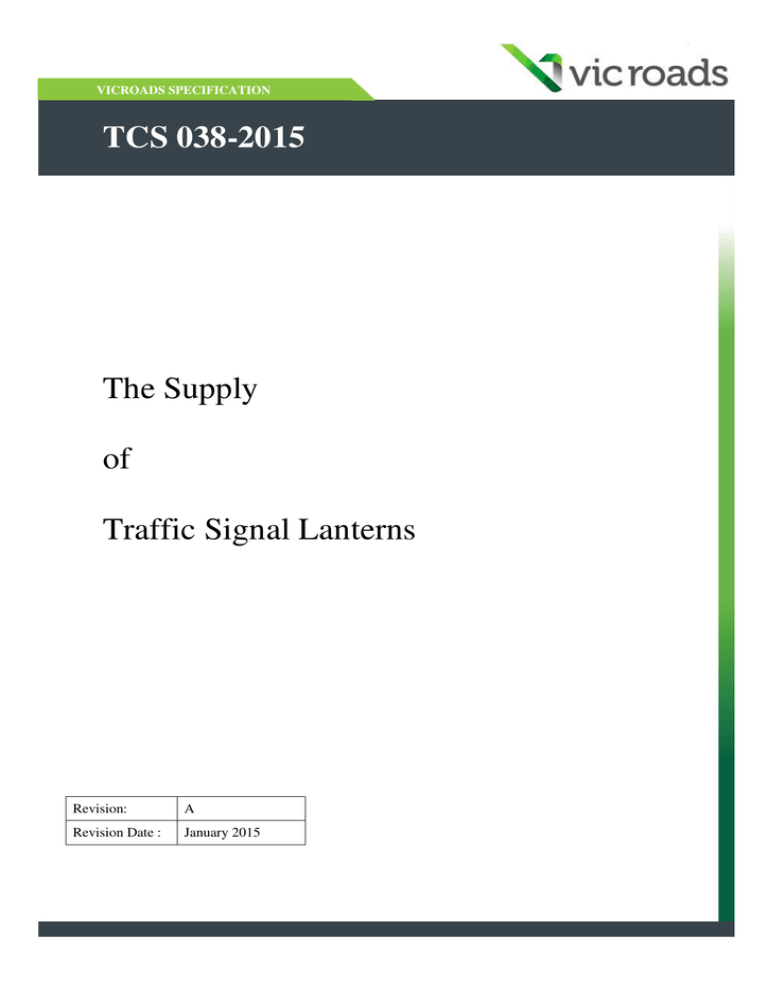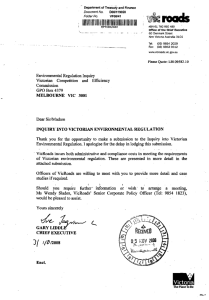
VICROADS SPECIFICATION
TCS 038-2015
The Supply
of
Traffic Signal Lanterns
Revision:
A
Revision Date :
January 2015
TCS 038 - 2015
Foreword
This specification has been developed by VicRoads. It is one of a number of
technical specifications, and associated standard drawings, which set out the
requirements for roadside ITS devices, traffic signal equipment and other
electrical equipment and associated devices and control systems.
This specification is intended for use in all relevant works undertaken by or on
behalf of VicRoads.
VicRoads Standard Drawings, Specifications and Guidelines are available for
downloading from VicRoads website at the following address
https://www.vicroads.vic.gov.au/business-and-industry/technical-documents
COPYRIGHT
© Road Corporation trading as
VicRoads. All rights reserved.
This document remains the
property of VicRoads. No part
of this document may be
reproduced or copied in any
form or by any means, electronic
or mechanical, including
photocopying, without the
written permission of VicRoads
Specification updates. VicRoads specifications and associated standard
drawings are subject to periodic review. To keep the specifications up to date,
amendments or new editions are issued as necessary. It is therefore important
for users of VicRoads specifications to ensure that they have the latest version
and associated amendments.
Road Operations
60 Denmark Street Kew 3101
Phone: (03) 9854 2111 Fax: (03) 9854 2319
Revision History
Revision
Date
Prepared by
Approved by
A (original)
January 2015
S. Purtill
H. Parsa
TCS 038-2015
PREFACE
A.
CHANGES TO THIS SPECIFICATION
A.1
The main changes to this specification from the previous version are listed below:
•
Revised in line with release of AS 2144:2014.
© Roads Corporation trading as VicRoads. All rights reserved.
Page 3 of 19
TCS 038-2015
Page intentionally left blank
Page 4 of 19
© Roads Corporation trading as VicRoads. All rights reserved.
TCS 038-2015
Contents
SECTION 1
1.1
1.2
1.3
SCOPE .....................................................................................................................................................7
GENERAL ..............................................................................................................................................7
DISPLAY TYPES ...................................................................................................................................7
SECTION 2
2.1
2.2
SCOPE AND GENERAL .............................................................................................7
RELATED SPECIFICATIONS AND DRAWINGS .................................................8
GENERAL ..............................................................................................................................................8
EXCEPTIONS AND CLARIFICATIONS TO AS 2144:2014 ...............................................................9
SECTION 3
ACRONYMS ...............................................................................................................10
SECTION 4
REQUIREMENTS ......................................................................................................11
4.1
4.2
4.3
4.4
4.5
4.6
4.7
MECHANICAL AND PHYSICAL REQUIREMENTS.......................................................................11
ELECTRICAL REQUIREMENTS .......................................................................................................11
DIMMING .............................................................................................................................................12
VISORS AND LOUVRES ....................................................................................................................12
CONTROLLER COMPATIBILITY .....................................................................................................12
HPSM LED TECHNOLOGY ...............................................................................................................12
LANTERNS USED WITH ELV ...........................................................................................................13
APPENDIX A ........................................................................................................................................14
REQUIREMENTS SPECIFIC TO HPSM LED’S ............................................................................................14
A1
BACKGROUND INFORMATION ......................................................................................................14
A2
DETERMINING LUMEN LOSS OF LED’S .......................................................................................14
APPENDIX B ........................................................................................................................................16
REQUIREMENTS FOR TYPE APPROVAL ..................................................................................................16
APPENDIX C ........................................................................................................................................19
INFORMATION TO BE SUPPLIED WITH ENQUIRY OR ORDER ............................................................19
© Roads Corporation trading as VicRoads. All rights reserved.
Page 5 of 19
TCS 038-2015
Page intentionally left blank
Page 6 of 19
© Roads Corporation trading as VicRoads. All rights reserved.
TCS 038-2015
SECTION 1
SCOPE AND GENERAL
1.1
SCOPE
1.1.1
This document covers the requirements for the supply of traffic signal lanterns for use within the State
of Victoria.
1.2
GENERAL
1.2.1
All traffic signal lanterns shall comply with the requirements of AS 2144:2014, Traffic Signal Lanterns.
1.2.2
Where this specification differs from the requirements of AS 2144:2014, this specification shall take
precedence.
1.2.3
All traffic signal lanterns, displays and associated hardware shall hold current VicRoads Type
Approval.
1.3
DISPLAY TYPES
1.3.1
Display types commonly used in Victoria are described in Table 1.1 below.
Aspect Type
Colour
Vehicle Roundel
Arrow Symbol
Red, Yellow, Green
Green (Walk), Red
(Don’t Walk)
Red, Yellow, Green
‘U’ Turn Symbol
Red, Yellow, Green
Bicycle Symbol
Red, Yellow, Green
‘Tee’ Symbol
Red, Yellow, White
‘E’ Symbol
White
‘B’ Symbol
White
Pedestrian
Table 1.1 – Common Displays
© Roads Corporation trading as VicRoads. All rights reserved.
Page 7 of 19
TCS 038-2015
SECTION 2
RELATED SPECIFICATIONS AND DRAWINGS
2.1
GENERAL
2.1.1
The fabrication and supply of all components shall conform to all relevant Australian Standards.
2.1.2
All installation works shall conform to the relevant VicRoads specifications and related specifications
and standards as indicated throughout this document.
2.1.3
The following related Australian Standards are defined:
2.1.4
2.1.5
AS 2144:2014
Traffic Signal Lanterns
AS 2339
Traffic Signal posts and Attachments
AS/NZS 3000
Wiring Rules
AS 60038
Standard voltages
The following related documents are defined:
IES LM-80
Approved Method: Measuring Lumen Maintenance of LED Light Sources
IES TM-21
Projecting Long Term Lumen Maintenance of LED Light Sources
The following related VicRoads specifications and standard drawings are defined:
Standard Section 730
Traffic Signal Installation
TCS 1127
Visor Dimensions
Page 8 of 19
© Roads Corporation trading as VicRoads. All rights reserved.
TCS 038-2015
2.2
EXCEPTIONS AND CLARIFICATIONS TO AS 2144:2014
2.2.1
The following changes or clarifications to AS 2144:2014 are summarised in Table 2.1 below.
AS 2144
Clause
3.3.4
3.5.2
3.7
4.1.1
4.1.2
4.1.3
4.4
5.2.2
5.3.1
6.2
7.5
7.6
Description
Exception / Clarification
Vehicular aspects with a circular display for other
technologies
Luminance distribution of vehicular aspects that display
symbols - Luminance
Luminance distribution of pedestrian and bicycle aspects that
display symbols
Size and arrangement of aspects
Mounting facilities
Access to optical system
Materials and methods of construction
Extra low voltage (ELV) operation
Supply conductors
Light output states
Visors and louvers
Target boards (for vehicular lanterns)
Table 2.1 – Changes and Clarifications to AS 2144:2014
© Roads Corporation trading as VicRoads. All rights reserved.
Clause 3.5
Clause 3.5
Clause 3.5
Clause 3.1.1
Clause 3.1.3
Not applicable
Clause 3.1
Clause 3.7
Clause 3.2.5
Clause 3.3
Clause 3.4
Clause 3.1.3
Page 9 of 19
TCS 038-2015
SECTION 3
3.1
ACRONYMS
The acronyms use in this document shall be interpreted as follows:
AS
AS/NZS
EMC
ELV
HPSM
IESNA
ITS
LED
LV
NATA
Page 10 of 19
Australian Standard
Australian / New Zealand Standard
Electromagnetic Compatibility
Extra Low Voltage
High Power Surface Mount
Illuminating Engineering Society of North America
Intelligent Transport Systems
Light Emitting Diode
Low Voltage
National Association of Testing Authorities
© Roads Corporation trading as VicRoads. All rights reserved.
TCS 038-2015
SECTION 4
REQUIREMENTS
4.1
MECHANICAL AND PHYSICAL REQUIREMENTS
4.1.1
Only 200mm lanterns are used in Victoria.
4.1.2
Lantern bodies can be plastic or metal.
4.1.3
Target boards shall be metal. Plastic target boards will not be accepted.
4.1.4
Mounting straps shall comply with section 4.1 of AS 2339. Specifically the lantern straps shall conform
to ‘size designation 3’ of Table 4.1 and be 300mm in length with 260mm ‘hole-centres’.
4.2
ELECTRICAL REQUIREMENTS
4.2.1
The typical voltages used in Victoria are:
-
240 volt a.c. LV mains supply (standard installation);
42 volt a.c. ELV (for specials installation as defined in individual tender documents); and
12 volt d.c. for solar installations (e.g. flashing yellow roundel and portable signals).
4.2.2
The default operating voltage for lanterns shall be deemed to be LV, as defined in AS 2144:2014 Clause
5.2.1, unless otherwise specified in individual tender documents.
4.2.3
The maximum wattage of LED aspects shall be 15 watts.
4.2.4
Connecting conductors shall be enclosed in a black flexible conduit not less than the length shown in
Table 4.1.
4.2.5
Connecting conductors shall extend beyond the end of the flexible conduit not less than the length
shown in Table 4.1.
Lantern Type
Flexible Conduit Length
Connecting Conductor Length
Pedestrian
3.9m
1.4m
2 Aspect Bicycle
3.9m
1.4m
All Other
2.3m
2.4m
Table 4.1 – Conduit and Conductor Lengths
© Roads Corporation trading as VicRoads. All rights reserved.
Page 11 of 19
TCS 038-2015
4.3
DIMMING
4.3.1
Either stepped or linear dimming is acceptable provided it is fully compatible with all VicRoads
approved traffic signal controllers.
4.4
VISORS AND LOUVRES
4.4.1
Visors typically used in Victoria are detailed in VicRoads Standard Drawing TC-1127 and shown in
Table 4.2 below.
Lantern Location
Visor Type
Visor Length
Cutaway
Primary
1
200mm
Open
Overhead
1
200mm
Open
Tertiary / Secondary
3
200mm
Closed
Pedestrian
4
200mm
None
Bicycle
4
200mm
None
Table 4.2 – Visors
4.4.2
Louvres are not typically used with LED displays.
4.5
CONTROLLER COMPATIBILITY
4.5.1
LED lanterns shall be compatible with the operation of, and allow full functionality with, VicRoads
Approved traffic signal controllers.
4.5.2
All lanterns shall be required to be subjected to traffic signal controller compatibility testing.
4.6
HPSM LED TECHNOLOGY
4.6.1
Lanterns that use HPSM LED technology shall comply with all relevant requirements of AS 2144:2014.
4.6.2
HPSM LED’s shall maintain sufficient lumen maintenance to ensure that at the end of the expected life
the minimum photometric performance is maintained.
4.6.3
To ensure that lumen maintenance levels are adequate, HPSM LED’s shall be tested to requirements of
the following IESNA standards:
• LM-80 – The standard method and procedure for measuring LED lumen depreciation; and
• TM-21 – Currently a memorandum which recommends a method to project the lumen maintenance
of an LED based on the results of LM-80.
Page 12 of 19
© Roads Corporation trading as VicRoads. All rights reserved.
TCS 038-2015
4.6.4
Where LM-80 and TM-21 test results are not available, other means of demonstrating compliance with
lumen maintenance requirements may be considered.
4.7
LANTERNS USED WITH ELV
4.7.1
Lanterns operating on 42 volts (ELV) shall be identified with the use of a light blue end cap located on
the lower end of the lantern as shown in Figure 4.1.
Lower End boss to
be light blue
Figure 4.1 – Light blue end boss for lanterns operating on ELV
© Roads Corporation trading as VicRoads. All rights reserved.
Page 13 of 19
TCS 038-2015
APPENDIX A
(Normative)
REQUIREMENTS SPECIFIC TO HPSM LED’S
A1
BACKGROUND INFORMATION
Section 3 of AS 2144 sets out the requirements for initial luminous intensity for the various signal colours.
Appendix E of AS 2144 details the basis upon which the initial luminous intensity figures were derived. Lumen
loss factors applied to initial luminous intensities are intended to ensure that, at the end of anticipated life (i.e.
100,000 hours for red and green and 10,000 hours for yellow), the minimum value of luminous intensity will be
achieved. For red and green displays this is 150cd.
AS 2144:2014 does not preclude the use of HPSM LED’s. To ensure that HPSM LED’s meet minimum
luminance intensity values at the required life, predicted lumen loss must be calculated.
A2
DETERMINING LUMEN LOSS OF LED’S
Clause 5.2.2.2 of AS/NZS 2144 requires that LED aspects be designed to provide a life expectancy of 100,000
for red and green and 10,000 hours for yellow. Actually testing LED’s for 100,000 hours is not practicable. In
order to determine LED life, IESNA together with the LED industry have developed a standard methodology
for testing LED’s. This methodology has been widely accepted throughout the LED industry. This has resulted
in two separate IESNA ‘standards’ being produced. These are:
• LM-80 – The standard method and procedure for measuring LED lumen depreciation; and
• TM-21 – Currently a memorandum which recommends a method to project the lumen maintenance of
an LED based on the results of LM-80.
LM-80 requires that:
a. A number of LED’s are tested under controlled conditions;
b. The tests are conducted at three different ambient temperatures, 55oC, 85oC (LM-80 specified) and a
third temperature specified by the manufacturer;
c. Initial measurements of lumens and chromaticity are taken;
d. Subsequent measurements of lumens and chromaticity are taken at nominal 1,000 hour intervals;
e. A minimum of 6 measurements (6,000 hours of operation) must be taken.
The resultant average lumen measurement at 6,000 hours is referred to as the average Lumen Maintenance at
6,000 hours. These results can then be entered into a standard TM-21 table which will then calculate the
extrapolated life expectancy when the LED will reach 70% (L70) or 80% (L80) of its initial lumen output. The
intent of this is to provide a guide as to the expected life of the LED under test.
Page 14 of 19
© Roads Corporation trading as VicRoads. All rights reserved.
TCS 038-2015
A2.1
Lumen Maintenance of a LED
To test the lumen maintenance of a LED:
a minimum of 20 units of LED’s should be used for each of the temperature settings;
tests are conducted at 55oC, 85oC and a third temperature specified by the manufacturer;
the initial measurements of lumens and chromaticity are documented;
the subsequent measurements of lumens and chromaticity at the nominal 1,000 hour intervals are
recorded;
• a minimum of 6 measurements are taken;
• additional measurements beyond 6,000 hours are encouraged; and
• the results are then used to populate a TM-21 table to calculate the average extrapolated life expectancy
to 70% of initial luminance.
•
•
•
•
A copy of the LM-80 test report, including the results of a TM-21 extrapolation to L70 is provided for each of
the required temperatures. An example of a summary of results of this testing are shown in Table A1.
Temperature
Number of LED’s tested
Measurement Current
Average Lumen Maintenance at
6,000 hours
Average Chromaticity Shift at
6,000 hours
L70 Extrapolation in hours
55oC
85oC
105oC
25
25
25
350mA
350mA
350mA
98.8%
97.5%
97.1%
0.0022
0.0022
0.0021
248,303
151,188
149,247
Table A1: Example summary of test results
Table A1 above shows an example of how a higher LED temperature decreases the lifespan of the LED.
© Roads Corporation trading as VicRoads. All rights reserved.
Page 15 of 19
TCS 038-2015
APPENDIX B
(Normative)
REQUIREMENTS FOR TYPE APPROVAL
OF A
TRAFFIC SIGNAL LANTERN
B1
GENERAL
To enable assessment for the purpose of granting Type Approval, the supplier is to submit a formal request for
Type Approval, for each lantern type submitted, accompanied by the following:
A complete working sample of the lantern.
An outline drawing showing the general presentation and overall dimensions of the complete
lantern.
Documentation to demonstrate that the lantern has been manufactured and supplied under an
approved quality assurance system.
Documentation to demonstrate that the lantern conforms to all relevant requirements of AS/NZS
2144:2014 and this specification. This may be by means of submitting test results, from approved
and appropriately qualified independent testing organisations, and providing the manufacturer’s
assurance that the product complies with each paragraph of the standard/specification.
•
•
•
•
The supplier may also submit evidence of Type Approval of the same product by another Australian State Road
Authority, together with details of volume and period of usage by other jurisdictions.
B2
REQUIRED NATA ACCREDITED TESTING
Notwithstanding B1 above, the supplier shall submit test results from a NATA accredited testing organisation to
demonstrate compliance with the following specific clauses of AS 2144:2014, where relevant to the particular
type of lantern submitted:
(a)
(b)
Clause 2.2
Clause 3.3
(c)
Clause 3.5
(d)
(e)
(f)
(g)
(h)
(i)
(j)
(k)
(l)
Clause 3.7
Clause 3.8
Clause 3.9
Clause 4.6.2
Clause 4.7
Clause 5.1.1
Clause 5.2.1.4
Clause 5.2.1.7
Clause 6.2
Page 16 of 19
Signal Displays
Intensity Distribution of Vehicular Aspects with a Circular
Display
Luminance Distribution of Vehicular Aspects with a
Symbolic Display
Luminance Distribution of Pedestrian and Bicycle Aspects
Veiling Reflections
Sun-Phantom
Weather Resistance – Required Protection
Operating Temperatures
Compliance with AS/NZS 3100
Provision for Aspect Monitoring
Electromagnetic Compatibility
Light Output States
© Roads Corporation trading as VicRoads. All rights reserved.
TCS 038-2015
B3
OTHER REQUIRED INFORMATION
The supplier shall also supply evidence of compliance with the following:
•
•
•
•
•
•
AS 2144:2002 Clause 5.2.2 Components and Construction;
Copy of LED manufacturers specification for each LED type used
maximum LED current ( no more than 70% full rated current);
minimum design life (e.g. 100k hours);
LM-80 test results;
TM-21 calculations;
VicRoads may require additional information or testing to be carried out as part of its evaluation of the product.
B4
CONTROLLER COMPATIBILITY
The supplier shall provide VicRoads evidence, such as test reports, that the lanterns are fully compatible with all
VicRoads approved traffic signal controllers. Where VicRoads decides to undertake compatibility testing,
lanterns shall be supplied to VicRoads (at no cost) for compatibility testing with VicRoads approved traffic
signal controllers. The required number of each type of lantern submitted may be as described in Table B1.
Lantern Type
Number Required
3 Aspect roundel vehicle
2
3 Aspect Arrow
2
3 Aspect ‘U’
2
2 Aspect Pedestrian
2
3 Aspect Tram Tee
2
2 Aspect Bicycle
2
3 Aspect Bus
2
Emergency Symbol
2
Table B1 – Minimum Number of Lanterns required for Compatibility Testing
© Roads Corporation trading as VicRoads. All rights reserved.
Page 17 of 19
TCS 038-2015
The lantern manufacturer/supplier may elect to be present for compatibility testing if desired.
The critical points of compatibility are:
Correct and accurate detection of ‘lamp fail’ alarm function for all groups; and
Last red out function.
•
•
B5
ASSESSMENT PROCEDURE
The assessment procedure for a traffic signal lantern may include the following:
•
•
•
•
•
Assessment of construction, workmanship and critical dimensions.
Preliminary assessment of the lantern under continuous burning at the VicRoads Test Rack for a
period of not less than three months.
Evaluation of the submitted data against the requirements of the specification
Successful completion of the controller compatibility testing for all approved controller types.
An on-road trial for a period of not less than three months.
Where some of these procedures have been completed prior to formal submission, the results will be considered
in the evaluation, provided there is no relevant change in the design of the lantern. The supplier is to state
whether tests carried out prior to formal submission were carried out on an identical sample of the lantern.
Page 18 of 19
© Roads Corporation trading as VicRoads. All rights reserved.
TCS 038-2015
APPENDIX C
INFORMATION TO BE SUPPLIED WITH ENQUIRY OR ORDER
(Informative)
The following information, as appropriate, should be provided with an enquiry or order for traffic signal
lanterns conforming to the requirements of this specification:
(a) The type of lantern display (ie vehicular roundel, vehicular arrow, pedestrian, bicycle, etc. and the
number of aspects of each lantern).
(b) The rated voltage of the electricity supply on which the lantern is to be capable of operating if not 2v0
volt AC mains supply (ie 42 volt AC mains supply or 12 volt DC solar operation).
(c) Details of any special purpose displays required.
© Roads Corporation trading as VicRoads. All rights reserved.
Page 19 of 19





